






Financial
Process
Mergers
Fractional

















Financial
Process
Mergers
Fractional









Kevin Bacon directed and starred in Loverboy , which starred Sandra Bullock, who was the main character in 28 Days that filmed in Black Mountain with my buddy working on set in lighting.
Boom – Bacon’s Law in three steps.
To be fair, if it wasn’t for our close family friend who has worked with the film industry for decades, my Kevin Bacon success rate would be much worse.
But this idea of connectedness – whether or not you believe the theory that everyone in the world is separated by six or fewer people – is an interesting one.
If you’re in business, you already know about the importance of forging connections and cultivating relationships. Even if you’re not in business, you know no one is an island, and connections are what help keep us sane or, in the case of the Blue Zones outlook, living longer.
For this year’s Commercial Real Estate issue, connectivity runs through the stories.
Our cover story subject is Lannin Braddock, co-founder of real estate company The Braddock Group. Part of her work includes working with developer clients outside the market and connecting them with area names. (Find out more about that as well as her other local projects on page 26.)
On page 30, you can read about a physical connector – the 1.75-mile-long Riverwalk that runs a thread along downtown Wilmington’s waterfront. In “Cutting a Path,” we look at the project’s history as a
tool to reposition downtown as a tourist destination in the 1980s to its potential future of spreading out even farther.
In “New Places to Play” (page 20), we look at the trend of recent commercial developments built solely to get people out and about together. From indoor pickleball to Dave & Buster’s, sizeable spaces are being built to address the market of socialization.
And in a very literal who knows whom, turn to the Residential Real Estate section on page 42 where we ask members of this year’s WilmingtonBiz 100 their recommendations for people who readers should know about.
While you’re here be sure to connect with us online, over email or actually in person –the annual Coastal Entrepreneur Awards are May 21. I’ll be there if you want to connect, and we can find the best Bacon’s Law of the night. Bring Kevin, and you’ll automatically win.

VICKY JANOWSKI, EDITOR vjanowski@wilmingtonbiz.com



MADELINE GRAY is a freelance documentary photographer based in Wilmington. With a master’s degree in photojournalism, her work is regularly featured in local and national publications. She enjoys spending time in places that are off the beaten track and collaborating to share the diverse stories found there. Gray photographed officials along the downtown Wilmington Riverwalk ( PAGE 30 ) madelinegrayphoto.com and @madelinepgray on Instagram

MALCOLM LITTLE is a portrait, editorial and brand photographer based in Wilmington. Originally from New Jersey, he began his creative journey as a professional dancer and choreographer before picking up a camera in 2021. Little photographed The Braddock Group co-founder Lannin Braddock for the cover as well as Reaves Chapel on PAGE 55, which just underwent a renovation. malcolmlittlephotography.com and @_malcolmlittle on Instagram

BARBARA L. NELSON has a diverse background in storytelling and journalism. She began her career by reporting for local newspapers in California, Louisiana and New York. Later, she became the editor of a real estate trade magazine in New York City. Currently, she works as a digital content creator. Nelson detailed several recent commercial projects built for new entertainment venues on PAGE 20 and talked with restaurateur Alex Zaragoza on PAGE 52 blncontentstrategy.com

CECE NUNN has been writing and editing for more than 25 years, currently working as managing editor and residential real estate reporter for the Greater Wilmington Business Journal. For this year’s commercial real estate section, she talked with real estate investor and broker and UNCW supporter Carlton Fisher on PAGE 44.
P ublisher
Rob Kaiser rkaiser@wilmingtonbiz.com
P resident
Robert Preville rpreville@wilmingtonbiz.com e ditor
Vicky Janowski vjanowski@wilmingtonbiz.com
M anaging e ditor
Cece Nunn cnunn@wilmingtonbiz.com
r e P orter
Emma Dill
edill@wilmingtonbiz.com
V
ice P resident of s ales & M arketing
Angela Conicelli aconicelli@wilmingtonbiz.com
s enior M arketing c onsultants
Maggi Apel
Craig Snow
M arketing c onsultants
Alexis Alphin
Jillian Hon
Jake Quilla
d igital M arketing c oordinator
Jessie Vincoli jvincoli@wilmingtonbiz.com
e V ents d irector
Jamie Merrill jmerrill@wilmingtonbiz.com
e V ents & M edia c oordinator
Alec Hall ahall@wilmingtonbiz.com
a rt d irector - e ditorial
Suzi Drake art@wilmingtonbiz.com
a rt d irector - M arketing
Tara Weymouth tweymouth@wilmingtonbiz.com
M edia c oordinator
Julia Jones jjones@wilmingtonbiz.com
d irector of f east W il M ington
Jessica Maurer jmaurer@wilmingtonbiz.com
c ontributing P hotogra P hers
Megan Deitz, Madeline Gray, Terah Hoobler, Malcolm Little, Will Page
s ubscribe
To subscribe to WilmingtonBiz Magazine,visit wilmingtonbiz.com/subscribe or call 343-8600 x201. © 2025 SAJ Media LLC










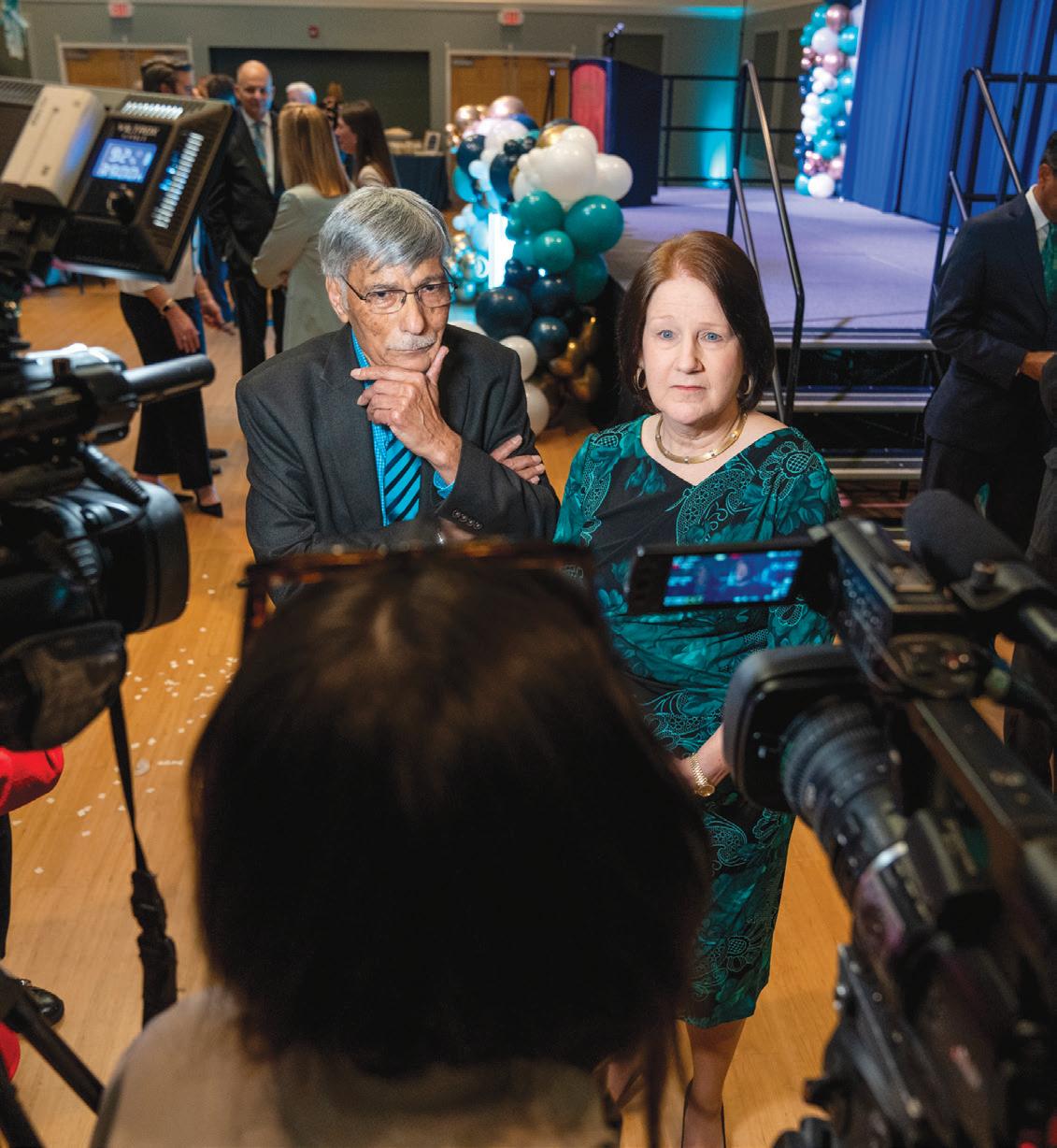
Wilmington residents Yousry and Linda Sayed were in the spotlight recently when they announced plans to donate $25 million to UNCW. The pledge marked the single largest donation in the school’s history.
Yousry Sayed is a member of the University of North Carolina Wilmington’s Board of Trustees and founder of Quality Chemical Laboratories. Linda Sayed is a partner with the law firm Block, Crouch, Keeter, Behm & Sayed. With the funding, university officials plan to allocate $20 million over the next five years to advance UNCW’s programs in medical education, clinical care, research and health care accessibility. The university will also designate $5 million to support teacher preparation.
HE WILMINGTON REGION HAS ALL THE INGREDIENTS NECESSARY FOR CONTINUED ECONOMIC DEVELOPMENT SUCCESSES AND GROWTH IN THE BIOTECHNOLOGY/LIFE SCIENCES INDUSTRY SECTOR.
1) INDUSTRY PARTNERS AND JOBS – With the long-standing local strengths in the clinical research and contract manufacturing industries, as well as recent investment announcements of over $1billion by Frontier Scientific Solutions in cold chain storage capacity here, the region is well-positioned for continued economic development successes in biotechnology.
The NC Biotechnology Center Southeastern Office’s biannual Clinical Research and Life Sciences Industry in Southeastern North Carolina 2024 report found employment in the life sciences sector continues to expand here, with over 5,600 life sciencesrelated employees living and working in the region.
On average, these jobs earn $113,838 per year, and we expect these opportunities to grow regionwide.
2) TALENT PIPELINE – To achieve this potential growth, the availability of a regional workforce who can access local jobs with transformational salaries through short-term certification training programs is paramount.
Many people think of biotechnology jobs as Ph.D.-level positions in a

research lab. While those roles are essential to the biotech industry, equally important are the jobs requiring minimal certification beyond high school or an associate’s degree, such as biomanufacturing roles.
With our NC Biotech Southeastern North Carolina Workforce Strategy, we are strengthening our talent pipeline at all job levels by supporting efforts to reach students at a young age to spark their interest in biotech careers, helping exiting military personnel transition to biomanufacturing jobs, implementing the BioWork short-term certification program at local community colleges and spreading the word about the broad spectrum of biotech career pathways through our Accelerate NC Ambassador Program.
3) EDUCATIONAL ASSETS – While degree programs at the University of North Carolina Wilmington continue to prepare professionals for careers at local biotech companies, the community colleges here and across the state are increasingly more vital workforce development drivers for the life sciences sector. Just look at the new Propel NC funding model for the state’s community colleges, which prioritizes investment in programs tied to workforce demand and high-wage jobs in high-growth industries in the state, such as biotechnology.
Similarly, the Boost Program, funded by a recent $35 million grant from Texas-based Arnold Ventures
through the partnership among the N.C. Community Colleges System, State Board and Foundation, is designed to help achieve the state’s economic development and workforce development goals “by accelerating student advancement through community college into high-wage, indemand careers.”
The program focuses on training North Carolinians to excel in careers that are essential to our state’s economic development success, including biotechnology, by breaking down barriers students often face in completing their education. Initial Boost participants include Cape Fear Community College.
4) INNOVATION FOCUS, COMMERCIALIZATION DRIVERS AND ENTREPRENEURIAL MINDSET – Wilmington is home to an impressive collection of entrepreneurial support organizations and initiatives to drive new venture creation here. In 2020, the NC Biotech Southeastern Office launched the biannual NC BIOTECH Venture Challenge in Wilmington with key partners at UNCW to focus attention and funding on early-stage biotech startups.
Local participating ventures include Isosceles Pharmaceuticals, Nuream, Boreas, Predicate, Duravax, Accugenomics, Electronic Lab Logs and OpiAID.
The contributions by UNCW to building our entrepreneurial community are immeasurable. With the leadership and innovative programs of the UNCW Center for Innovation and Entrepreneurship and the Office of Innovation and Commercialization, we are seeing a greater focus than ever on moving ideas from the minds of local life sciences innovators and university
researchers to the marketplace.
These biotechnologies are not limited to the pharma-related products many of us think comprise life sciences but also include innovations in marine biotechnology, aquaculture, energy generation and agriculture.
5) FUNDING SOURCES – Without adequate financial resources, these economic development wins would not be possible. The NC Biotechnology Center’s grant and loan programs and other entrepreneurial resources play a key role in supporting innovation, commercialization, entrepreneurship and company growth.
Another statewide resource with local representation, NC Innovation, recently made a significant grant award to UNCW and Dr. Ying Wang for his groundbreaking work on a universal, longer-lasting flu vaccine, which was also part of last year’s NC BIOTECH Venture Challenge preventure track.
Equity capital and governmental research funding are also critical ingredients for biotechnology commercialization and venture creation, as is the philanthropic generosity of local leaders.
The recent announcement of a $25 million gift to UNCW by Linda and Yousry Sayed, focused on supporting a wide range of health care professional workforce programs and research initiatives, will have a long-term, transformational impact on the university and the region.
If you have an appetite for life sciences economic development in Southeastern North Carolina, you’ll love the feast we’re cooking up and the table we’re setting for future biotechnology successes across the region.
Randall Johnson leads the NC Biotechnology Center Southeastern Office, serves as treasurer for the N.C. Community Colleges Foundation and is a past president of the N.C. Economic Development Association. REACTIONS, OPINIONS AND QUOTABLES

WHAT, IF ANY, DISCRETIONARY SPENDING (MOVIES, GOING OUT TO EAT, ETC.) HAVE YOU CUT FROM YOUR BUDGET TO COPE WITH INFLATION?
“I HAVEN’T BOUGHT 1 thing from Amazon since October 31st. It was before the launch of the boycott. And I’ve never liked Target or Walmart. But, there are many that have no options.” – GINA MULLINAX
“MOVIES, EXTRA TRIPS TO TARGET , church clothes, shoes, driving trips, flowers for yard but not veggie seeds and plants, less eggs for breakfast, anything remotely fun that costs $, also charitable giving cut back. Things for the grandchildren.” – BETTY WYNNE
“NOTHING ” – ROBERT SWARTWOUT
“PAID BEACH PARKING ” – MIKE SMITH
“NO MORE TAKE OUT. No more tater tots.” – Josh Sanie
“ALL OF IT WE’VE CUT from our budget. We simply cannot afford any extras.” – TOSH LONGO
“WHEN LUNCH THAT USED to cost $5 now costs $10, dinner was $10 is now $25, going out to eat becomes a deep financial decision.” –JIM FRANCIS

X (FORMERLY KNOWN AS TWITTER) POLL: @WILMINGTONBIZ
ACCORDING TO THE U.S. BUREAU OF LABOR STATISTICS, WHILE MOST FULL-TIME EMPLOYEES IN THE COUNTRY WORK 40 HOURS A WEEK, THE AVERAGE NUMBER OF HOURS WORKED PER WEEK IS AROUND 34.6. HOW MANY HOURS DO YOU THINK A FULL-TIME EMPLOYEE SHOULD WORK?

“I KNEW IT WOULD HIT HARD … but it’s beyond what I thought it would do.” - JOAN EDGE, OWNER OF EDWARDS HALLMARK, ON THE LONGTIME MAYFAIRE TOWN CENTER STORE’S CLOSING SIGN UP FOR DAILY NEWS UPDATES AND SUBSCRIBE TO THE
T R A N S F O R M Y O U R S P A C E , E l e v a t e Y o u r B u s i n e s s




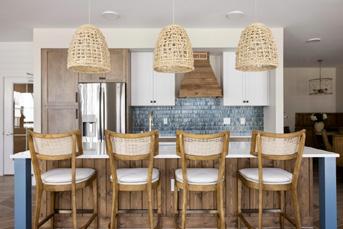

While most individuals are better off financially than they were pre-pandemic, the significant increase in interest rates coupled with the significant migration we witnessed over the past few years has made owning a home more challenging.
Economists largely agree that an important component of dealing with housing affordability requires a robust increase in supply.
The increase in development is, however, often met with resistance by residents who view this increased construction as putting stresses on an area’s roads, schools and infrastructure.
At the local level, we are experiencing a similar situation with prices currently about 60% higher than they were five years ago. (Editor’s note: To read more about housing costs in the region, turn to page 20 in the Residential Real Estate section.)
This increase was partially

driven by the increase in population the area experienced during the height of the pandemic.
A fundamental question facing the area is whether the pandemic-era growth was temporary and therefore not reflective of changes that need to be addressed or if the inmigration and housing demand is here to stay and supply needs to respond in an appropriate manner.
The most recent data released by the Census might have some important answers.
At the state level, North Carolina added 164,835 individuals, which translates into a 1.5% growth rate between 2023 and 2024.
At the local level, the Wilmington metropolitan area continues to be one of the fastest-growing parts of the state. It is comprised of once again the fastest-growing county in the state: Brunswick County at 4.54% growth rate, or 7,257 individuals, the seventh fastestgrowing county. The metro area also includes Pender at 2.52%,
or 1,721 individuals, and the 29th fastest-growing county as well as New Hanover at 1.37% or 3,279 individuals.
This data points to continued growth towards the region, albeit at a slightly lower rate.
All three counties mentioned above grew at a slightly lower rate between 2023 and 2024 than between 2022 and 2023.
However, to put the increased demand for housing in context, Brunswick County today has 20% more individuals than it did in 2020, Pender County 14% more and New Hanover County 7% more.
There is no doubt that change is challenging and absorbing growth is difficult, but migration of the scale the area experienced and continues to experience will undoubtedly continue to put upward pressure on prices unless there is a significant effort to increase supply.
Addressing the housing question in an appropriate manner will be key to not only help the area’s residents but also remain an attractive destination for companies and talented individuals.
Mouhcine Guettabi is a regional economist with UNCW’s Swain Center and an associate professor of economics at UNCW’s Cameron School of Business.
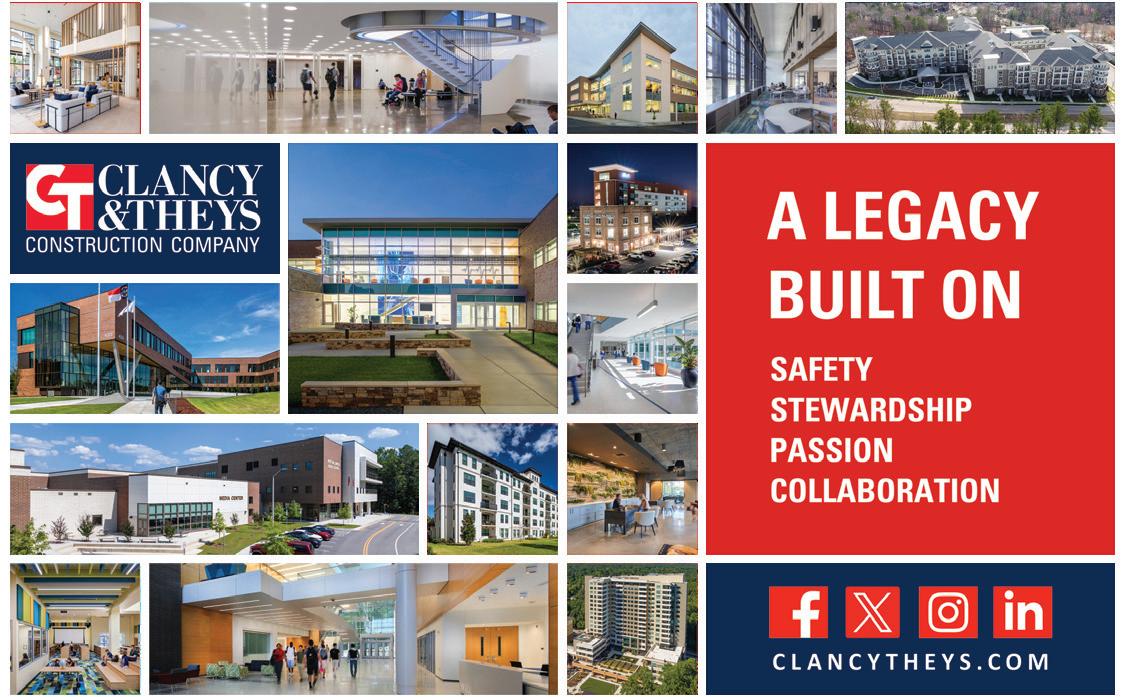


BY EMMA DILL
construction on U.S. 421 is expected to create more than 1,000 full- and part-time jobs in the Wilmington area.
Amazon officials and local leaders announced details of the project in mid-March during a ceremonial groundbreaking event. The largest in North Carolina, the facility will span more than 11 football fields with more than 3 million square feet in floor area across four-and-a-half floors, officials said.
The site is in both Pender and New Hanover counties.
The path to bringing the fulfillment center to Wilmington hasn’t always been easy, said Scott Satterfield, president and CEO of Wilmington Business Development Satterfield. Like any big project, it’s had its ups and downs, he said.
In early 2022, Seefried Industrial Properties, a firm representing Amazon, backed out of a purchase contract for the site.
Things picked back up, and last August, Amazon purchased the more than 170-acre site that was once home to the former BASF vitamin plant, which closed in 2009. Crews broke ground on the project in October.
Construction of a fulfillment center typically takes between 18 and 24 months, said Holly Sullivan, Amazon's vice president of worldwide economic development. That means the Wilmington facility could open in late 2026 or early 2027.
“What you see rising behind me will soon become North Carolina’s largest and most advanced robotics fulfillment center with the footprint of more than 650,000 square feet,” Sullivan said at the event.
The Wilmington fulfillment center is considered a “first-mile” facility where employees pick, pack and ship customer orders alongside robots. It will serve customers in the Southeast and nationwide, Sullivan said.
She said it was the region’s available local workers and a “unicorn” site that helped draw Amazon to the region. Because the land straddles New Hanover and Pender counties, an interlocal agreement has helped streamline the planning and permitting for the facility, Sullivan added.
Because of its location, Amazon will pay taxes to both counties, according to Satterfield.







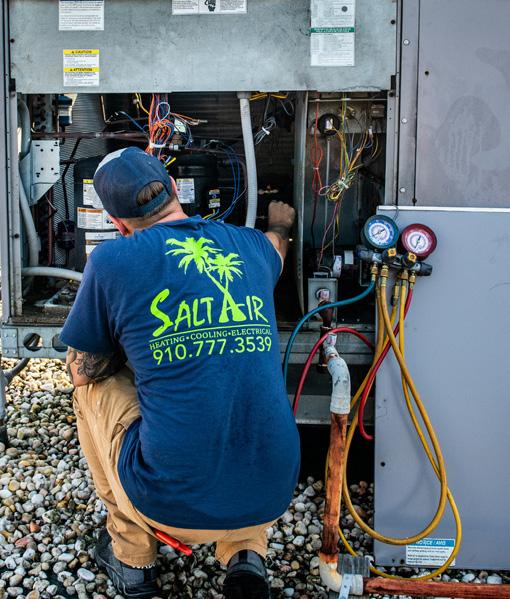
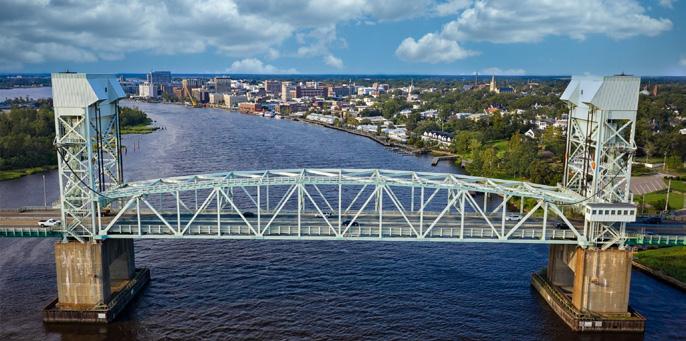
The replacement effort for the aging Cape Fear Memorial Bridge will continue, officials said in March, despite $242 million in federal funding now being up in the air for the transportation project, which is seeing its estimated cost grow to potentially $1 billion.
“Although federal funding has been paused, we are still moving forward with our planning process,” said Landon Zimmer, a Wilmington resident and member of the N.C. Board of Transportation.
On March 5, the N.C. Department of Transportation (NCDOT) confirmed that the grant funding had been put on hold.
“At this time, all USDOT discretionary grants are paused, per the Feb. 26 Executive Order,” Andrew Barksdale, NCDOT communications officer, wrote in a statement, referring to the Trump Administration’s order implementing the Department of Government Efficiency (DOGE).
“We are working with our federal
partners to determine when the grant for the Cape Fear Memorial Bridge could move forward,” Barksdale added.
The $242 million in federal funds, announced in July as part of more than $5 billion in Large Bridge Project awards nationally, was the largest grant announced toward the project for replacing the bridge built in 1969. At the time of last year’s announcement, the cost was expected to be $485 million. The estimated price tag has increased significantly to potentially $1.1 billion, according to transportation officials.
“NCDOT will continue to work with its partners at the WMPO (Wilmington Urban Area Metropolitan Planning Organization),” Barksdale said, “to move the project forward and continue to pursue the completion of the necessary environmental documents. The department is on track to finish those documents in 2026.”

Construction is moving ahead on MedNorth Health Center’s newest building.
The two-story structure is set to add approximately 35,000 square feet to the health center’s campus. Construction is expected to wrap up in March 2026.
MedNorth Health Center CEO Althea Johnson said space constraints of the existing 17,000-square-foot MedNorth clinic, located at 925 N. Fourth St., have hindered operations, limiting the number of patients clinic providers can serve daily.
“The significance to us is that we’ll finally be unburdened by the space restraints,” Johnson said. “We will be able to improve our operations and hopefully improve just the overall quality of the work that we do, as well as patient satisfaction.”
NUMBER OF ILM NONSTOP DESTINATIONS ONCE AVELO AIRLINES ADDS ITS
FLIGHTS IN JUNE (ALSO
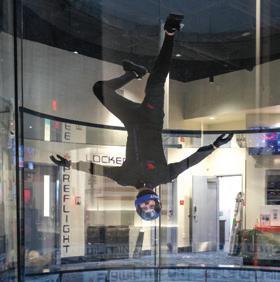

ABY BARBARA L. NELSON | PHOTOS BY MADELINE GRAY
S THE WILMINGTON AREA’S POPULATION CONTINUES TO EXPAND, NEW ENTERTAINMENT AND RECREATIONAL VENUES ARE EMERGING TO ADDRESS THE INCREASING DEMAND FOR ACTIVITIES-BASED DEVELOPMENTS.
From indoor skydiving to arcades drawing adults, several new projects have recently opened or are under construction now.
Strikes LLC, for example, will begin developing a 40,800-square-foot indoor/ outdoor family entertainment complex spanning 6 acres at 5601 Oleander Drive. The facility is slated to open during the fourth quarter of 2026.
The plans for the complex feature a 29,100-square-foot ground floor with 10 bowling lanes (eight public, two private), arcade games, shuffleboard, air hockey, axe throwing, a kitchen area, private
rooms, an indoor bar that opens to the outside and a 30-foot programmable LED screen above the main level’s bar. Above the ground floor will be an 11,600-square-foot mezzanine with duckpin bowling, billiards, multisport simulators and other gaming areas. Outside, there are plans for six pickleball courts and space for cornhole and yard games.
“We are especially excited about our outdoor offerings on and around our turfed patio and activity area, including pickleball courts, patio and counter seating serviced by our indoor bar, and lawn games including cornhole and trash can pong,” a spokesperson for the project said. “With our Park Avenue entrance providing connectivity to the River-to-Sea Bikeway, it’s easy to imagine riding bikes with friends to Strikes on a warm spring day for a cold beverage and an afternoon, or evening, of fun.”
The project is expected to be completed in the mid-to-late second quarter of 2026. Strikes will operate the completed facility, with plans to hire a


general manager with a background in managing an entertainment center of this size and scope and additional staff.
“Strikes will offer a unique appeal to all ages,” the Strikes’ spokesperson said. “Whether it be playing the latest arcade games in our modern arcade, welcoming corporate groups to our public or private bowling and axe throwing lanes, or meeting friends and family to watch the big games on our sports bar’s 30-foot LED screen.”
Earlier this year, the Wilmington City Council approved the project’s conditional rezoning request, because its size exceeded the 5,000-square-foot limit of the previous zoning classification. The site is currently unused but previously hosted various businesses, including Backyard Paradise Swingsets and an internet cafe.
Another addition to Wilmington’s entertainment scene is Dave & Buster’s, which is set to open its doors this summer at Mayfaire Town Center. The restaurant/arcade franchise operates 220 locations across the U.S. and Canada, offering a combination of dining, drinking, gaming and socializing.
The new Wilmington venue will feature a 5,000-square-foot bar, a 6,500-square-foot restaurant, a 12,500-square-foot arcade and largescreen TVs for sports viewing.
Dave & Buster’s serves American fare including burgers, steaks, seafood and pasta. The venue also offers 160 games such as Luigi’s Mansion, Pac-Man and other popular arcade classics. Players can collect tickets, which can be redeemed for prizes such as Apple products, game consoles and stuffed animals.
Guests under 21 may enter only if accompanied by a guardian who is at least 25 years old.
Not too far from Dave & Buster’s new footprint in Mayfaire Town Center, a highly visible entertainment attraction also went vertical on Eastwood Road.
Since its grand opening late last year, iFly has welcomed flying enthusiasts to the indoor skydiving destination.
“We truly feel embraced by the Wilmington community and surrounding areas as a premier location for family fun, entertainment and training,” said Dave Soler, the local franchise’s chief growth officer. “We have flown thousands of guests since we opened our doors in December.”
The Wilmington iFly $14-million facility located at 1441 Eastwood Road is one of over 80 locations worldwide, and the only other North Carolina site is near Charlotte. Co-founders of the local facility are Patrick Maguire and George “Jamie” Jamison. Maguire serves as general manager, while his brotherin-law Soler focuses on business development. Plans are underway to open additional locations across Eastern North Carolina and South Carolina.
“It is incredibly fulfilling to bring so much enjoyment to the community, allowing people of all ages and abilities, from ages 3 to 103, to experience the dream of flight in a fun and safe environment,” Soler said.
The 5,500-square-foot, 65-foottall facility primarily operates on a reservation basis, allowing walk-ins and offering corporate/group tickets. After check-in, customers receive flight gear and meet their instructor for a safety briefing. Conflict Kinetics has partnered with the facility, which also features a 270-degree simulator room. It is the first iFly location to offer an additional attraction beyond the wind tunnel.
“We have begun military training in our facility and will continue to support the training and readiness of our country’s military members,” Soler said. “We are honored to provide a safe training environment to support our national defense.”
iFly Wilmington also offers a student field trip program that combines fun and hands-on learning


in a state-of-the-art wind tunnel. This program allows students to experience aerodynamics, physics and engineering through interactive experiments.
“There has been tremendous excitement for our educational STEM Field Trip program with numerous schools, summer camps and youth groups already signing up to experience the science, technology, engineering and math that brings iFly Wilmington to life,” Soler said.
To capitalize on the rapidly growing popularity of pickleball in the U.S., the Wilmington area is home to two indoor venues: Pickle & Taps and House of Pickleball. Recent research from the Association of Pickleball Professionals shows that about 48.3 million adult Americans played pickleball last year.
Pickle & Taps, 1207 S. 13th St.,
opened last year on New Year’s Eve. The 30,000-square-foot building formerly occupied by Queensboro Shirt Company was intentionally redesigned to enhance pickleball play and the social aspect of the sport. It provides a comfortable setting with ample seating and a bar that features over 10 local craft beers on tap.
“Business has been good, and we are blessed to be a part of the fastestgrowing recreation sports industry in the U.S.,” said Kayse Beasley, who co-founded Pickle & Taps with her husband, Jason. “We have an amazing pickleball community in ILM and the Cape Fear region.”
All courts feature Save My Play, an AI-powered camera technology that lets players record games or training for coach reviews and social media sharing.
Players can also use Court Reserve
to view schedules and book play.
The venue hosts Dynamic Universal Pickleball Rating events, helping players build ratings for local, regional and national tournaments.
House of Pickleball (HOP), 115 Long Pine Drive in Leland, opened in 2018 and has 12 indoor cushioned courts, permanent nets and high ceilings for top-tier play.
In 2023, to handle increased patronage, it enlarged its space from 12,000 to 30,000 square feet and is expanding its offerings again this spring.
“We are opening a concession stand inside the HOP this May, called the Drop Zone, where we will serve beer, wine and light snacks,” said co-owner Todd Muffley. “We also have acquired the land next to our facility. … You never know what will come next.”


BY BETH A. KLAHRE
PHOTO BY MALCOLM LITTLE
When Lannin Braddock, COO of The Braddock Group, a real estate company she co-founded with her husband, Michael, in 2019, heard about the development happening in the Soda Pop District of downtown Wilmington, she knew she wanted to be involved.
Michael, originally from Wilmington, had previously shown Braddock this part of the city. Braddock kept her eye on the prize for years. “We always said this area could really be something one day with the right people involved,” Braddock said.
When Parastream Development, a venture partnership founded by Andy Hewitt and Sandy Thorpe, decided to redevelop the area once home to Wilmington Soda Pop Co., Electric Soda Pop Co. and the Coca-Cola Bottling Facility, Braddock reached out to them to introduce herself.
“I was persistent in staying in touch with Andy and beyond honored to present my ideas to showcase a space for a future restaurant. He wanted a different approach – social media and unique marketing,” she said.
Braddock invited restaurant groups, brokers and the media to a showcase that included food and drinks and worked with Hewitt to create a restaurant concept rendering to be displayed on the exterior of 920 Princess St.
The Braddock Group is also involved in the leasing of future office spaces planned in the redevelopment of 717 Market St. Owned by husbandand-wife team Chris and Natalie Capone, the 13,000-square-foot building is set to welcome its first members in May.
“It’s unlike anything that Wilmington has now,” Braddock said. “Locally owned and locally grown. That’s the beauty of it.
“This gem of a building is intentionally planned to be a community collaborative environment with hyper-small 150- to 250-squarefoot offices geared toward startups that don’t need a large space and solopreneurs who are trying to build a team,” explained Braddock.
The amenities include an on-site gym, plunge pool, sauna, locker room, podcast studio, conference rooms, rooftop terrace and onsite parking.
“It’s right around the corner from the Soda Pop District. I say I have a corner of Wilmington where I planted my flag,” said Braddock.
Braddock’s interest in real estate stems from her childhood. Her father had a career in commercial real estate. “My first interest was on the legal side. That morphed into brokerage in 2007 when I moved to Wilmington,” she said. “I still ask my dad a lot of questions and run scenarios by him. He is my encyclopedia.”
The Braddocks had been involved in real estate for years before starting The Braddock Group. Michael Braddock was involved in on-site residential sales across the Southeast for nearly two decades. The couple first worked together in Brunswick Forest in Leland. Lannin Braddock was hired for property management and sales and leasing for the commercial side of the development, and Michael was hired for on-site new development sales.
“I got a crash course working alongside the regional property manager, over time becoming the property manager at Brunswick Forest,” said Lannin Braddock. “I learned how to look at market comps, costs to build and costs to lease. Working alongside the property manager, who had a wealth of knowledge and years of expertise, was the best education.”
In 2017, Braddock took a break when the couple’s daughter was born, but she never got out of the real estate game, staying involved in Cape Fear CREW (Commercial Real Estate Women), a networking organization,
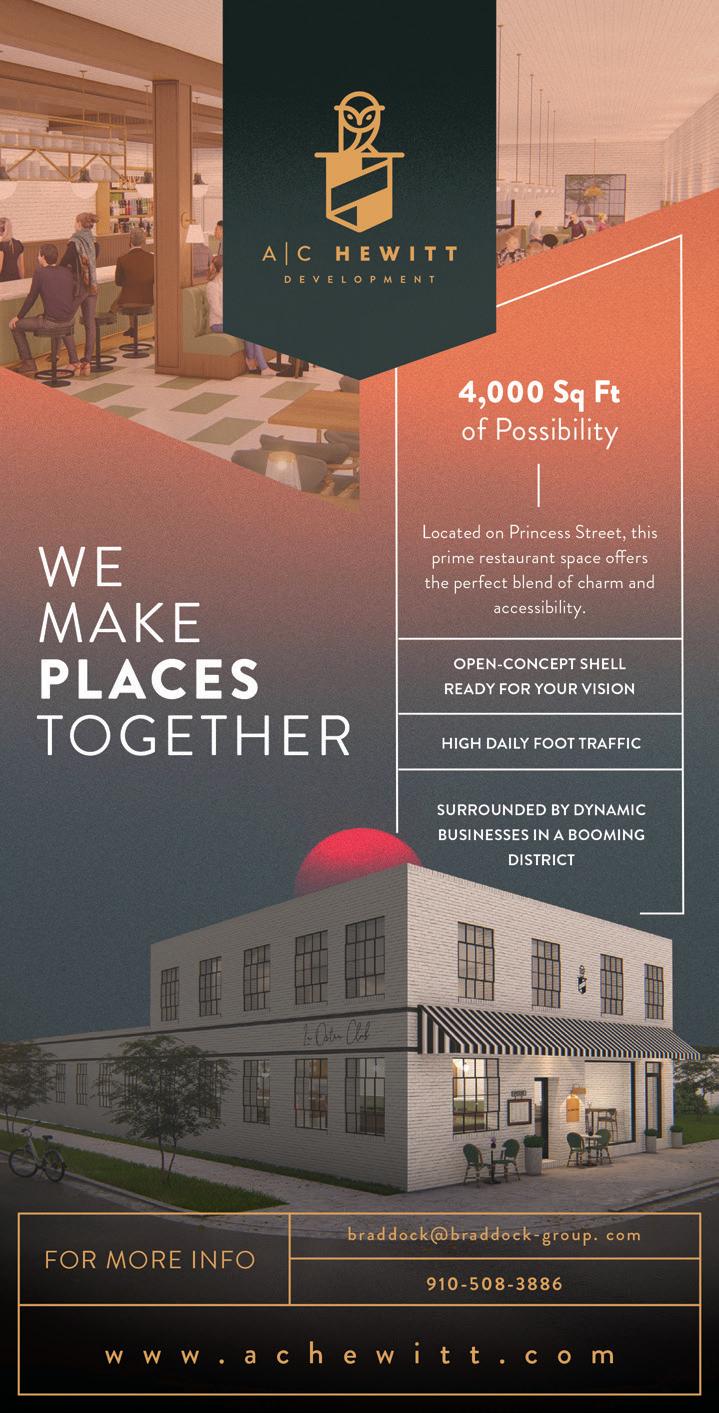
and remaining in touch with the tenant and business community. During COVID, she became an advisor on leasing, including the legal aspects. Seeing the organic growth, Michael, who Braddock describes as “an entrepreneur through and through,” suggested his wife open her own real estate business.
“Spending that time making connections was the right recipe and ingredients to open my own business,” Braddock said.
She got her broker in charge license in 2019, opened the business in 2020 and convinced Michael to join in 2021.
In March, the Realtors Commercial Alliance of Southeastern North Carolina bestowed Braddock with its 2024 Real Estate Rockstar Award.
“She’s been a dynamic force in the industry, and her journey thus far is nothing short of remarkable,” according to the award announcement.
The commercial side of The Braddock Group handles traditional buying and leasing, representing tenants, buyers, sellers and landlords, and every side of traditional commercial transactions. The residential team handles traditional buying and selling of homes, connecting with builders and developers for land acquisition, scattered lot programming and sales and marketing.
“We act as developer consultants offering expertise and knowledge of the market. Most of our developer clients have been out of state, and we have local market knowledge and connections. We are a rolodex to developers,” Braddock said.
That ability to make connections is key, Braddock said.
“I have spent years developing relationships, helping people find the synchronicity to work as a team and deliver the outcomes that clients expect. That is also the most fun,” she said. “I love a good project.”


What started as a downtown revitalization project has become the thread connecting business along the Wilmington waterfron t
PBY VICKY JANOWSKI | PHOTOS BY MADELINE GRAY
art of downtown Wilmington’s revitalization story has been hammered home over several decades, one board at a time.
Work on the Riverwalk along the Cape Fear River started more than 40 years ago. Initially a project to help rebrand downtown Wilmington, over the years the wooden pathway spread out from its nucleus at the foot of Market Street.
Now spanning 1.75 miles, it runs between Nun Street and almost to the Isabel Holmes Bridge – the river flowing along one side, a ribbon of commerce along much of the other.
In all, it’s taken more than $40 million to build the Riverwalk’s sections, according to city officials, who also say that more than $250 million in riverfront development has sprung up in recent years with access to the pathway.
Looking ahead, some would like the route to continue and move the line farther out, but that likely will take more time and more funds.
Riverwalk South, as city officials called the portion starting at Nun Street, isn’t the oldest portion of the walkway. But it does tie in a string of shops and restaurants on the end of South Water Street embedded in historic district homes and converted buildings, such as Chandler’s Wharf, warehouse space built in 1884 that now houses stories, galleries and eateries.
The project to install the boardwalk between Nun and Dock streets, as well as pocket park spaces dotting the path, was finished in 2003 and cost $2.6 million, according to the city.
A series of waterfront restaurants from Nun Street to Market Street with outdoor dining off the Riverwalk – or in the case of the floating setup of Anne Bonny’s Bar and Grill – draw visitors during tourism season.
“As soon as the weather gets nicer, it brings people out,”
said Rebecca Geyer, general manager of River 128, one of the first restaurants where people could dock their boats on the river and step off to dine in Riverwalk South.
It opened as The George in 2004 on the still-new walkway stretch and earlier this year closed briefly for an overhaul. Reopened in February under its new name of River 128, the longtime restaurant at 128 S. Water St. reemerged with a remodeled interior, new menu and new head chef, Andrew Meade.
“We do have some regulars, mostly I would say it’s tourism (driven),” Geyer said. “We’d like to get more locals.”
With about 30 tables outside overlooking the boardwalk, the swath of river and Cape Fear Memorial Bridge, the setting often draws walk-ins, Geyer said.
“We get a lot of the foot traffic that comes off the Riverwalk,” she said.
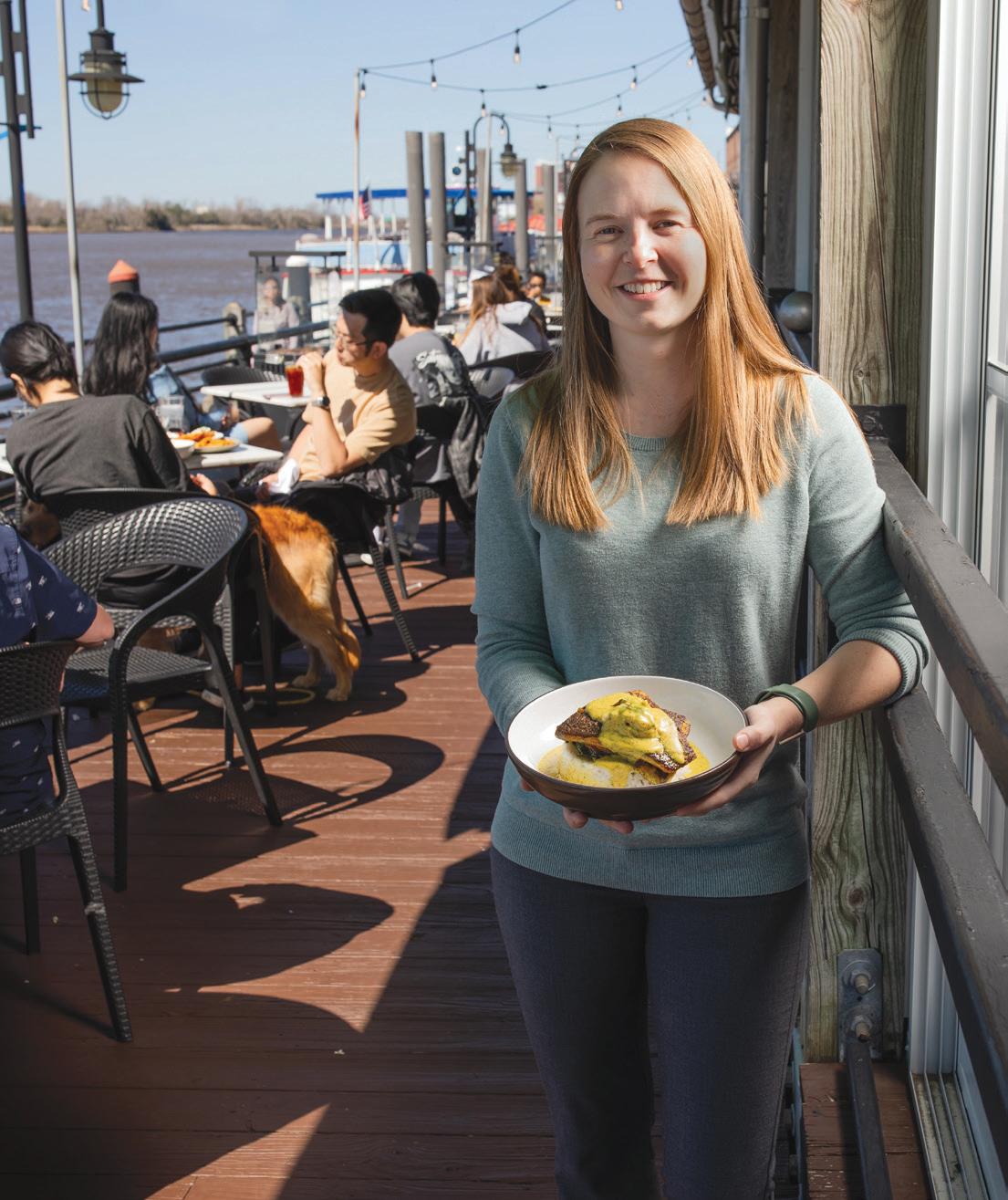
In 1980, construction started at the base of Market Street on the Riverwalk.
Leaders with the Downtown Area Revitalization Effort (DARE) – a precursor to today’s Wilmington Downtown Inc. group –advocated for the project as part of its overall efforts to redesign the area as a tourist destination.
“As major retailers moved out of downtown, a seedier side moved in. An early focus for DARE was to eliminate the adult-bookstore and topless-bar businesses that had taken hold downtown,” Gene Merritt, who had served as DARE’s executive director, wrote in 2019.
“Also in those early days, DARE established Riverfest and persuaded the Azalea Festival to add a downtown street fair,” he wrote. “Perhaps the biggest accomplishment was the beginning of construction of the Riverwalk, giving people a reason to come downtown and enjoy its greatest asset – the Cape Fear River.”
In the decades that followed, segments of the walkway took shape, and the pathway ran farther north past a mix of spaces including the Alton Lennon Federal Building and Courthouse with its rising steps facing the river, Water Street Park, the recently added mixed-use River Place development, Cape Fear Community College waterfront buildings, hotels and the Wilmington Convention Center, which opened in 2010.
Work wrapping the boardwalk around the convention center took place the next year in a nearly $2 million project.
Tying into the walkway is one of the amenities for the convention center, said Fredia Brady, the facility’s general manager.
“It’s a huge asset,” said Brady, who joined the convention center in 2017. “If we didn’t have that, we could be in any city anywhere. It does enhance the overall experience for our attendees.”
Besides having an outdoor strolling space for those attending events and meetings at the center, the path’s connectivity also can be a convenience for visitors staying overnight.
At times, Brady said, attendees forego their courtesy buses or vans in lieu of walking to restaurants and stores in the main commercial district.
“It’s an easy connection to local happenings,” she said.
Local tourist officials took bragging rights in 2021 when the Riverwalk received national nods against its counterparts in other cities. The Wilmington asset came in No. 2 that year in USA Today’s Readers’ Choice Awards for Best Riverwalk, falling behind the Detroit International RiverWalk but besting the Chicago Riverwalk.
The Wilmington Riverwalk is a finalist in the reader poll again this year, with voting ending April 7.
“Located along the Cape Fear River, Wilmington’s riverfront is home to a colorful riverwalk lined with more than 200 cafes, bars, and shops,” states the description on the voting page, which as of press time had Wilmington in third place on the leaderboard.
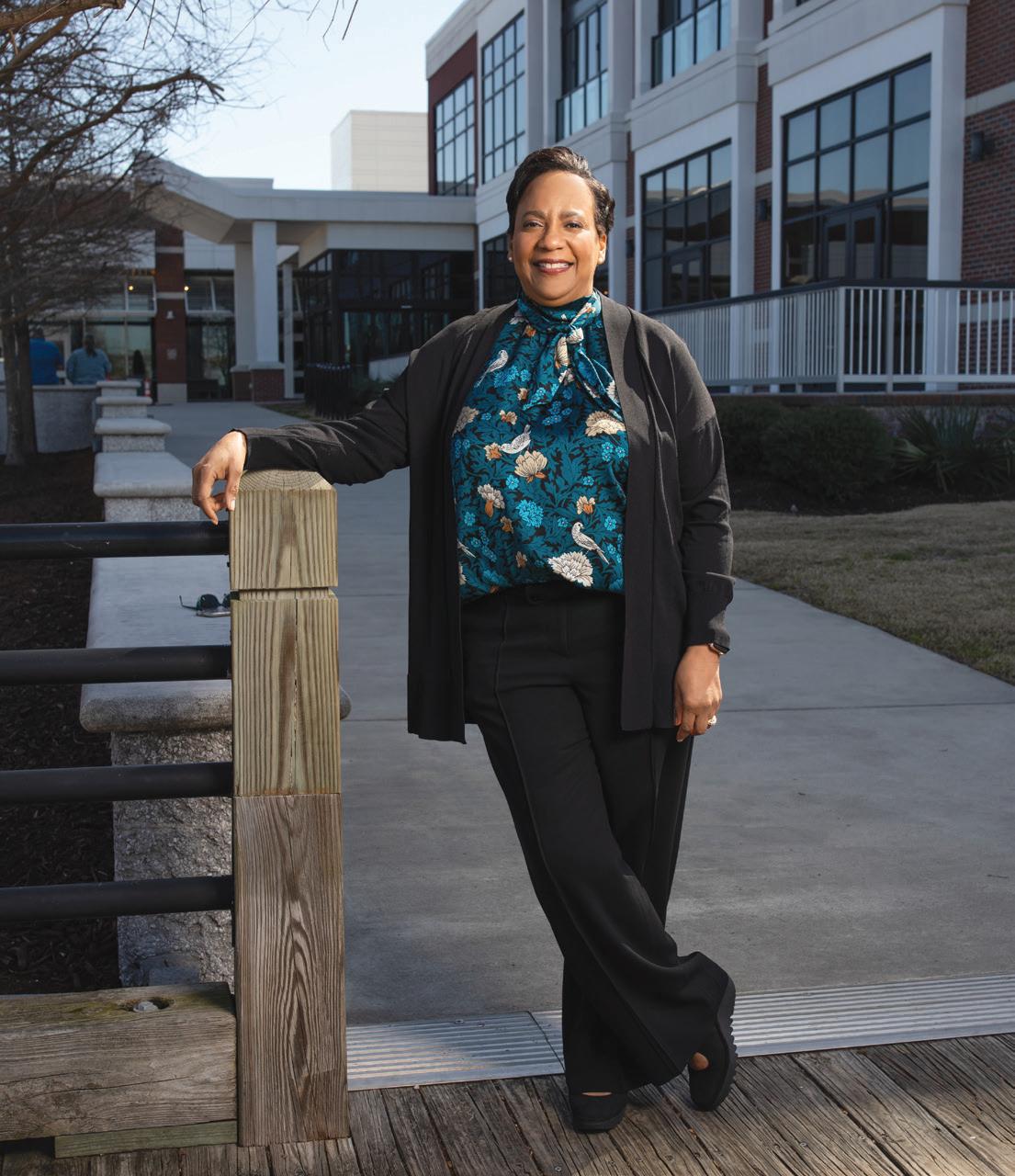
In 2017, Wilmington Mayor Bill Saffo stood at the spot where Riverwalk construction began 37 years earlier and declared the project done.
Others since have said, hold on a minute.
In 2023, a feasibility study was done looking at extending the Riverwalk from where it stops now at Sawmill Apartments to under the Isabel Holmes Bridge.
Wilmington City Council members in late 2023 heard the results of the study, which looked at four possible routes to extend the boardwalk farther north.
One proposed route extends it 2,200 feet along the river past Cape Fear Marina and Off the Hook Yachts, which contributed money toward the feasibility study with the city paying for the rest from the city council’s contingency funds.
The estimated cost for that route, which is the longest extension looked at in the study, was $8 million to $10.8 million depending on the decking material.
Other studied routes turn to Cornelius Harnett Drive before the marina, with varying paths farther away from the river. Estimated costs range from $5.2 million to $7.2 million for those options depending on the route and the materials.
The impact of having the Riverwalk pass by your property can be a benefit as private developers have seen on the most recent additions to the northern end.
In 2013, USA InvestCo entered into a public-private partnership with the city to extend the Riverwalk as the company built its northern riverfront development that converted an old shipping and rail channel for the Atlantic Railroad Co. into what is now Port City Marina, The Cove Riverwalk Villas houseboats and two restaurants.
USA InvestCo gave the city an easement on the property to have the Riverwalk connect through, and the company built that segment of the pathway.
The city reimbursed the company for construction costs on that extension, which cost $5 million.
The walkway now ties in north of Port City Marina to travel past the cityowned Riverfront Park and Live Oak Bank Pavilion amphitheater before stopping at Sawmill Apartments, which were built next to the bridge in 2017.
“One of the most important things that we hear from our customers is how it ties the historic downtown to the newer part of downtown and the marina district that we developed,” said Anthony Lucchino, vice president of USA InvestCo.
Lucchino said the walkability aspect of downtown helps set it apart.
With the development of the northern riverfront area, several new apartment buildings were built in the past five years, bringing residents clustered around the city’s 6-acre park.
From fairly recently introduced apartment dwellers on one end to retailers in historical buildings on the other, the thread that connects them is the Riverwalk.
“It really ties together the different parts of downtown,” Lucchino said.
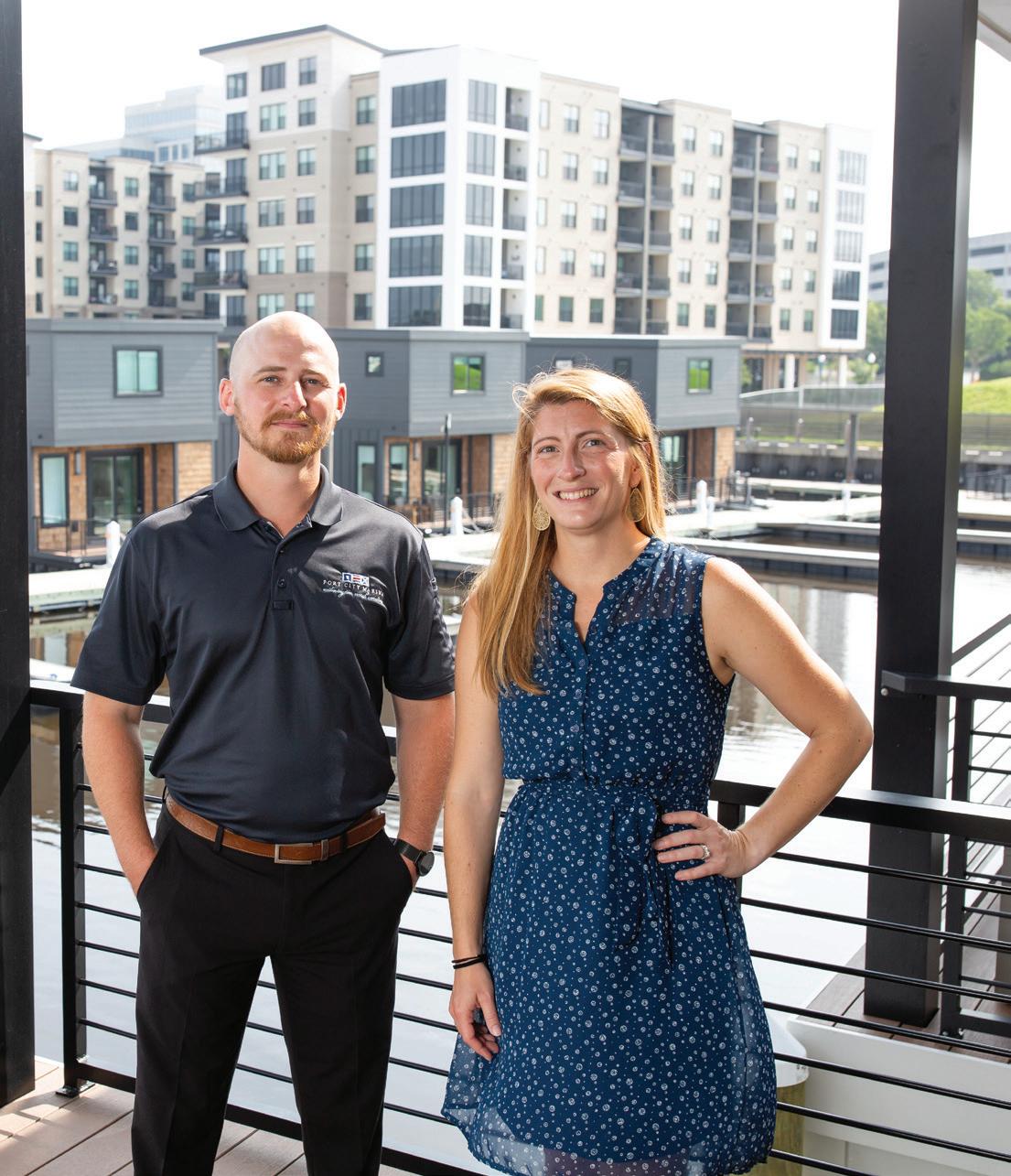

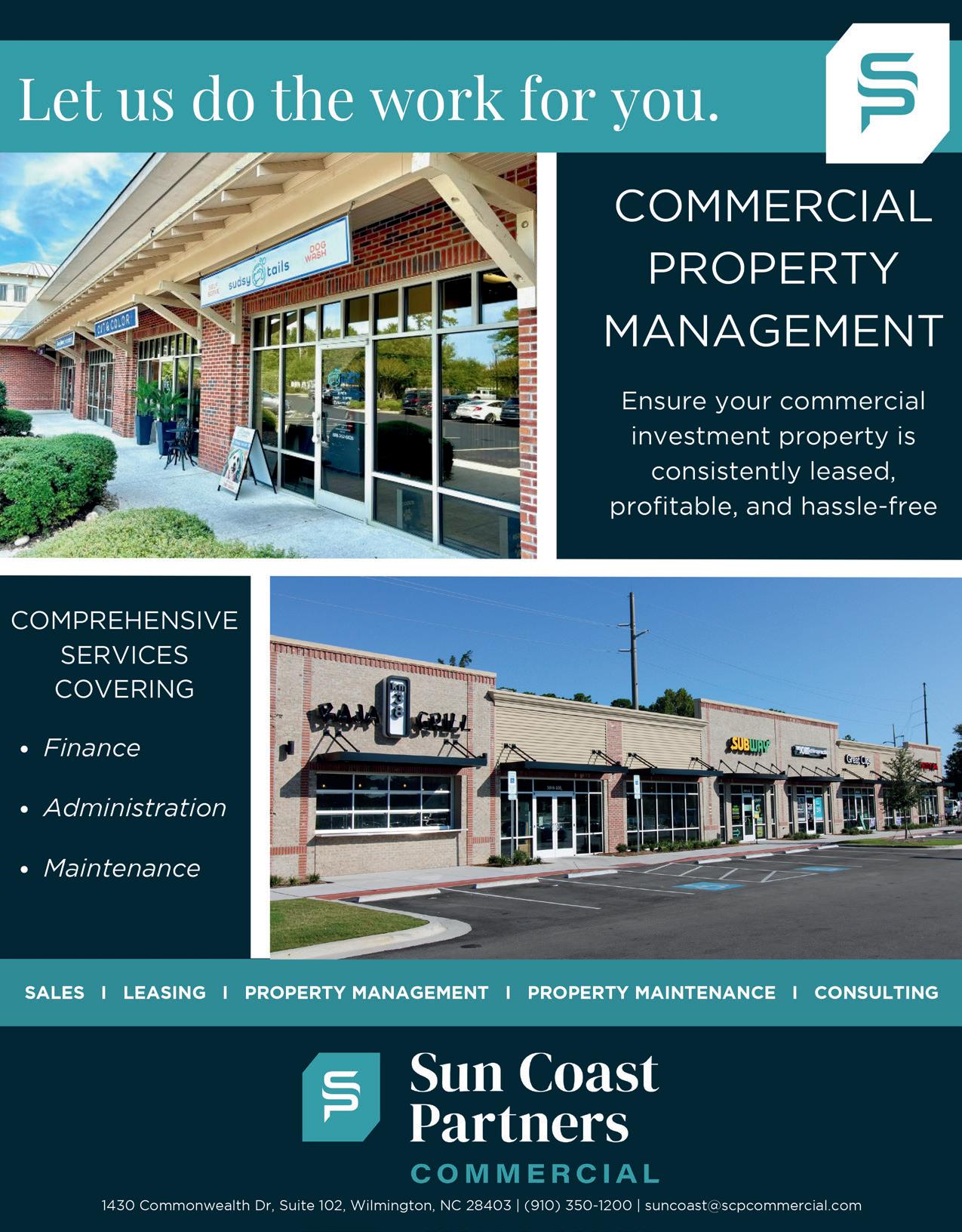
BY EMMA DILL
Local governments continue to engage in partnerships and incentives to drive housing and commercial growth in the region. The following highlights some of these projects.
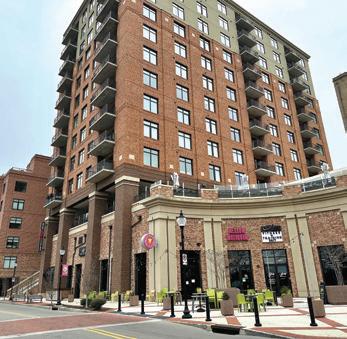
14 GRACE ST.
STATUS : Completed
DESCRIPTION: The 13-story, mixed-use River Place complex was completed in 2020. The public-private partnership between the city of Wilmington and East West Partners replaced a defunct parking deck with a new parking deck along with 79 apartments, 92 condominiums and ground floor space for commercial tenants.
East West Partners began the process of converting the complex’s apartments into condos in 2024, and the development firm is currently negotiating the purchase of the building’s commercial space, which it has leased from the city since 2018.
PARTNERS: City of Wilmington, East West Partners
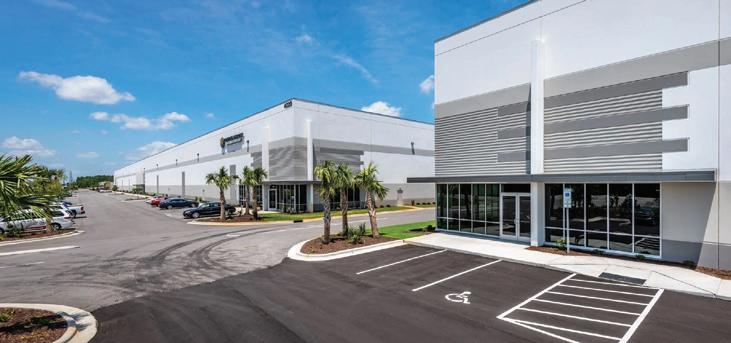
4220 N. U.S. 421
STATUS: Under construction
DESCRIPTION: Wilmington Trade Center is a master-planned industrial park on U.S. 421. In 2021, developer Edgewater Ventures acquired the industrial park’s first 25-acre tract, where it built two buildings with 315,000 total square feet of Class A industrial space. The company acquired another 187-acre tract in 2023 with plans to expand the industrial park.
Developers have said that, once complete, the park will include 13 buildings, ranging from 84,000 to 1 million square feet. The entire industrial park would encompass a combined area of more than 3.2 million square feet. The proposed structures will be shell buildings that can be leased or sold to business users.
Last spring, New Hanover County leaders approved $3.3 million in economic incentives to help fund the project’s infrastructure. The agreement structures the incentive’s payout into three buckets based on infrastructure investments, direct site investments and jobs created. The buildings proposed for the Wilmington Trade Center could add between $300 million to $400 million to the county’s property tax base and generate more than 1,500 jobs for the area, officials have said.
Work is currently wrapping up on the park’s third building, with plans for two additional buildings moving through the permitting process to stay ahead of the demand.
PARTNERS: New Hanover County, Edgewater Ventures
TIMELINE: Incentive funding for the project will be paid in tranches on a pro-rata basis through 2031.
by Will Page
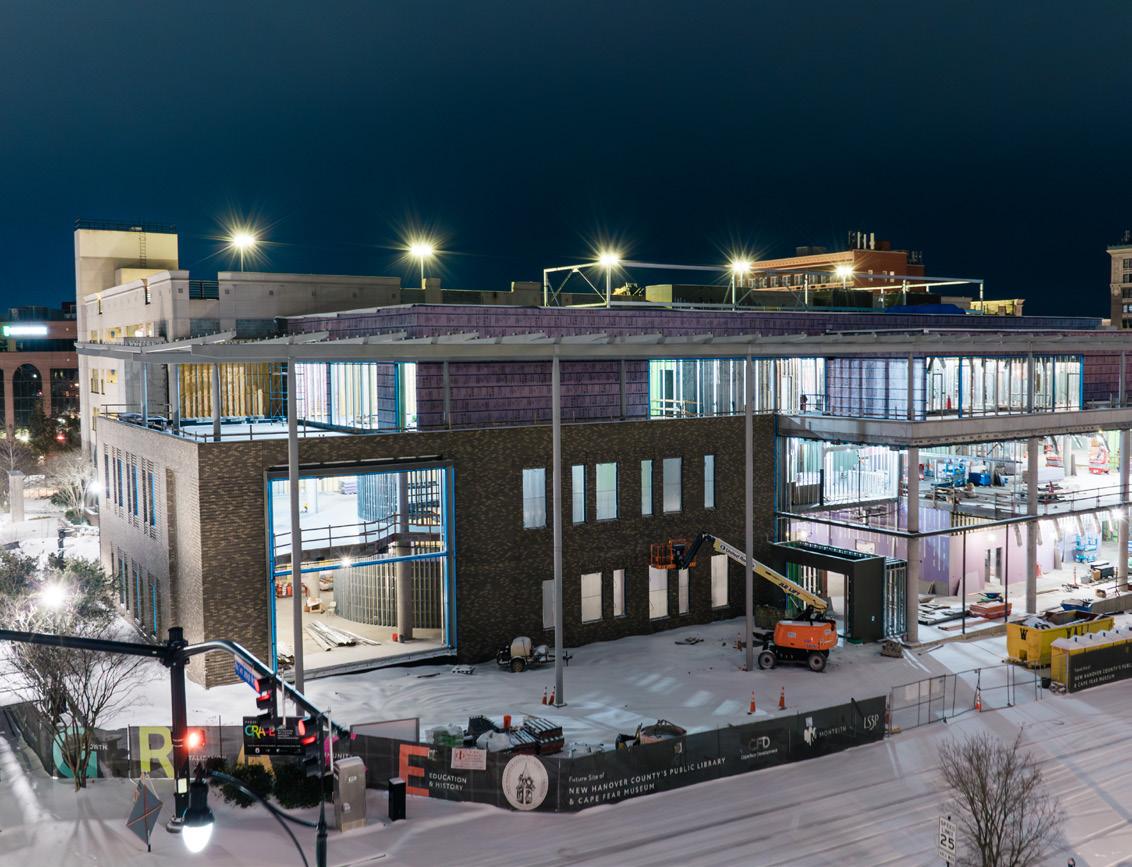
STATUS: Under construction
DESCRIPTION: At the corner of North Third and Grace streets, Project Grace is the $56 million redevelopment of New Hanover County’s downtown library branch and the Cape Fear Museum. The project, which is currently under construction, is a public-private partnership between New Hanover County and Cape Fear Development, the development arm of Wilmington-based firm Cape Fear Commercial.
The current project is the second iteration of a public-private partnership. Initially, county leaders partnered with Wilmington-based Zimmer Development Co., but those efforts came to a halt when the N.C. Local Government Commission failed to approve the proposed $80 million lease agreement.
A few months later, in May 2023, county leaders approved a new development agreement with Cape Fear Development. Per the new agreement, the county would
pay a development fee of $3.5 million, and the cost of the new museum, library and parking deck improvements should not exceed $60.5 million. Once the new construction is complete, the county will sell the current library site to Cape Fear Development for no less than $3.5 million.
That site would then see an expected $30 million in private investment, including residential and commercial development. Construction would have to start within 24 months of the library and museum facility’s completion, per the agreement. According to Brian Eckel, a partner with Cape Fear Development, details of the project’s private development are expected to be released in the fourth quarter of 2025.
PARTNERS: New Hanover County, Cape Fear Development TIMELINE: The library portion of the project is expected to be turned over to New Hanover County in August, with the library being operational by late 2025, according to Monteith Construction CEO Bryan Thomas. Work on the museum portion is expected to wrap up by late 2025, with the museum potentially opening in mid-2026.

Enterprise Phone and Conferencing Systems
• Affordable
• Inclusive
• Integrated

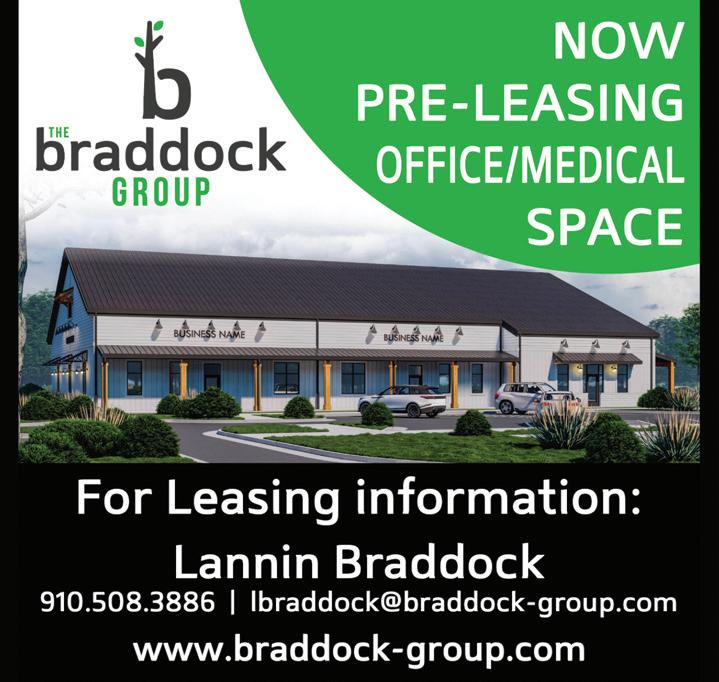
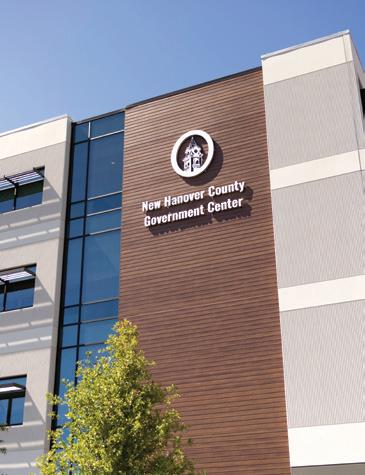
STATUS: Public portion completed; private development planned
DESCRIPTION: In spring 2023, county employees moved into New Hanover County’s new government center. The building replaced the former facility, originally a shopping center, which the county purchased and renovated in 2002.
New Hanover County leaders approved a development agreement with Cape Fear FD Stonewater LLC in January 2021, and a few months later, construction began on the project. Under the agreement, the county would own the new government center site but would sell about half of the 15-acre site to the private developer.
The private development, called Proximity Government Center, is a mixed-use project that will include 256 apartments along with retail and restaurant space, according to Eckel. Work on the project is expected to start during the second quarter of 2025.
PARTNERS: New Hanover County, Cape Fear FD Stonewater LLC
TIMELINE: The project’s public side was completed in late 2022, while work on private development is set to begin in mid-2025.

1,400 ACRES NEAR BRUNSWICK FOREST
DESCRIPTION: A proposal to bring a minor league baseball stadium to Leland struck out in early 2024 when the town of Leland and REV Entertainment, a management partner for various sports teams, decided not to continue pursuing the stadium.
The project was slated for 1,400-acre tract near Brunswick Forest. A feasibility and economic impact study funded by the town estimated the development cost of the baseball stadium at $105.6 million. The stadium proposal sparked both support and pushback from Leland residents, who raised concerns about the stadium’s cost and the impact it could have on the town’s existing neighborhoods and infrastructure.
TRACTS NORTH OF DOWNTOWN WILMINGTON
DESCRIPTION: The city of Wilmington has eyed land on the north end of downtown Wilmington for an expansive gateway development.
The city began negotiations with development firm East West Partners on a project that would include apartments, public parking, 35,000 square feet of commercial space, offices and a hotel.
But plans for the partnership fell apart after high interest rates, workforce housing requirements and other market factors led to the decision not to move forward.
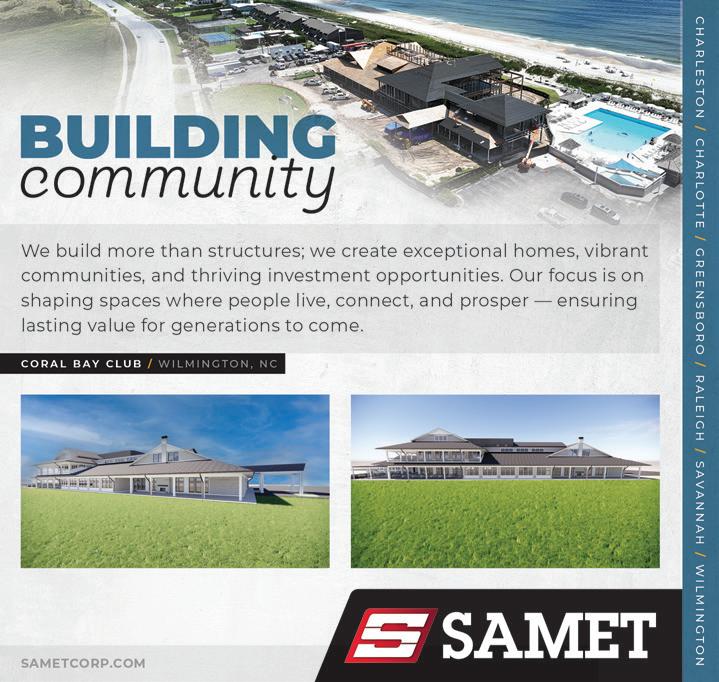




The local commercial real estate market continues to see new development with buildings in the works across the industrial, medical and nonprofit sectors. National retailers are flocking to the Wilmington market, and local brokers continue to see high demand for small- and mid-sized office spaces.
BY EMMA DILL
Wilmington is finally seeing its share of attention from national retailers. Within the past year, Mayfaire Town Center saw the opening of clothing retailers Free People, FP Movement, Aerie and an expanded lululemon, with a Dave & Buster’s and J. Crew Factory, among other national retailers, slated to open later this year.
Steve Hall, vice president of Wilmington-based commercial real estate firm BlueCoast Commercial, said it’s taken a few years for major retailers to catch on to the nuances of the Wilmington market, including the substantial role of summertime tourism in helping fuel the area’s retail sector. Hall noted that retail lease rates in the Wilmington area have climbed.
Amid the ebb and flow of individual retailers, shopping centers saw investment over the past year. At Hanover Center, that investment has included remodeling the shopping center’s facade and replacing its monument signs, while at Landfall Shopping Center, new paint, awning replacements and upgrades to the center’s monument signs have been in the works.
From building a new campus to planning for more space, local nonprofits are expanding.
Last year, the Salvation Army broke ground on a 20,500-squarefoot facility off Martin Luther King Jr. Parkway in Wilmington. The building, which is nearing completion, will include a 75-bed homeless shelter and a “central hub” for the nonprofit’s social services outreach program.
WARM NC recently moved into a newly renovated building in Ogden. The nonprofit purchased the property in the fall of 2023 and spent months upfitting it into WARM’s offices and warehouse. CEO Andy Jones said the building gives WARM room to grow.
Two other major nonprofits, the YMCA of Southeastern North Carolina and YWCA Lower Cape Fear, are preparing for growth. The YMCA is working on plans to grow its midtown facility and has plans to build another in northern New Hanover County, while the YWCA has selected an architecture firm to guide an upcoming expansion and renovation.
At a national level, vacancy rates in the office market are still close to all-time highs. The national vacancy rate in February was 19.7%, according to a report from CommercialEdge. But in much of the Wilmington area, office supply is tight, Hall said. The office market is “extremely tight” in the Mayfaire and Landfall areas because of a lull in recent construction.
“We’ve had developers come in, and they produce product,” Hall said, “and it’s been absorbed.”
That lack of supply stems, in part, from high construction costs, Hall said. He said smalland mid-sized office spaces are in the highest demand, with about 6,000 square feet being the “sweet spot.”
In recent years, the city of Wilmington has leased thousands of square feet of office space to other tenants using its new headquarters, Skyline Center, in downtown Wilmington. Former city office buildings have also been repurposed as new users have purchased or leased the properties.
Health care organizations made progress in 2024 and early 2025 on plans to grow their local footprints.
Novant Health acquired a former Verizon Wireless call center in midtown Wilmington last fall for outpatient clinics on two floors. Two Novant Health Michael Jordan Family Medical Clinics opened their doors over the past year on Greenfield and North 30th streets.
Construction is ongoing on Novant’s Scotts Hill Medical Center, a 250,000-square-foot community hospital with a surgical focus. Ernie Bovio, president of Novant Health NHRMC and the Novant Coastal Region, said they health system has long-term plans to add a 120bed cardiovascular tower to its 17th Street campus.
MedNorth Health Center broke ground late last year on an expansion that will add approximately 35,000 square feet to the health center’s campus. CEO Althea Johnson said the additional space is sorely needed and will help improve the health center’s patient services and operations.
Amid big announcements, demand for industrial space has remained steady in the Wilmington market.
Last fall, Frontier Scientific Solutions announced plans to build a 500,000-square-foot warehousing facility in the business park at Wilmington International Airport. Amazon recently held a ceremonial groundbreaking for a massive robotics fulfillment center just south of the Pender County Commerce Park.
Despite the recent attention from big players, Hall said many of the industrial leases he handles are from smaller companies entering the Wilmington market. They’re usually looking for spaces between 5,000 and 20,000 square feet.
Construction continues on the Wilmington Trade Center, a masterplanned business park on U.S. 421 that could bring 3.3 million square feet of Class A industrial space to the area. New Hanover County leaders committed to more than $3 million in incentives to help fund the project’s ongoing development and investment in the site.
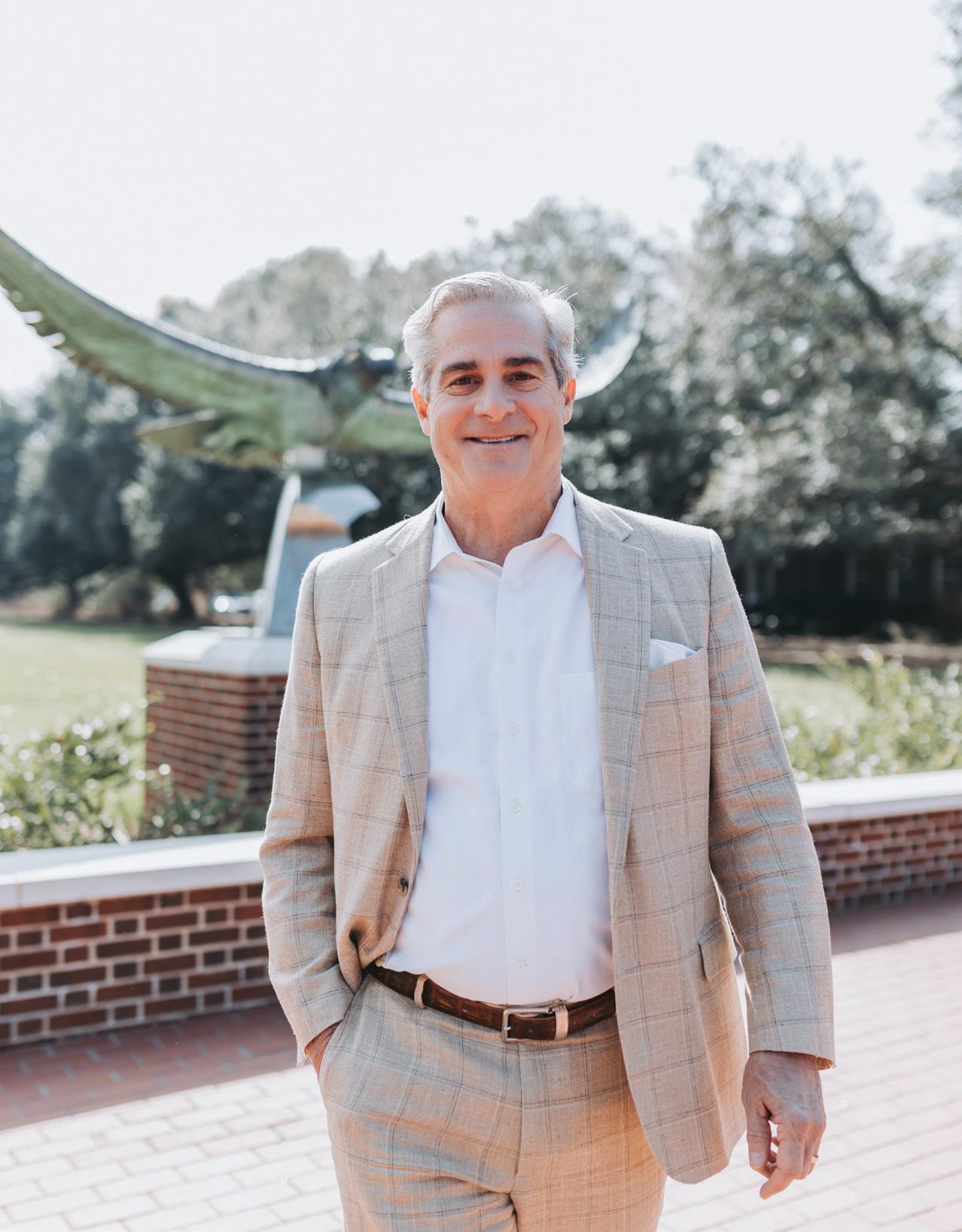
BY CECE NUNN
PHOTO BY TERAH HOOBLER
Carlton Fisher earned his real estate license at age 18. He attributes the early certification to his dad. A well-known figure in local real estate and as a UNCW donor before he died in 2018, Herbert Fisher told his son to get the license because the state’s real estate commission was getting ready to increase requirements.
“Here I am, the summer of my senior year in high school after I graduated, and he says, ‘I want you to take the real estate exam,’” said the now 64-year-old Carlton Fisher, more amused now than he was then.
At the time, he didn’t want to do it. But his father said, “I don’t care if you never use it again. It’s just like an insurance policy in your back pocket.”
The Fisher family had been buying property in Wilmington since the 1920s, and as a result, Carlton Fisher’s portfolio of commercial real estate today includes investments in retail, industrial and office space.
“I’m very blessed – 99% of my properties are occupied, and overall, the market has remained fairly strong,” he said.
One of the local assets Fisher points to is the University of North Carolina Wilmington, a school his family has supported with millions in donations and from which he graduated. This year, Fisher is the chairman of the UNCW Board of Trustees, after serving on numerous boards “to prepare me for what goes on campus and know the lay of the land,” he said.
It’s an important commitment to Fisher, not only because of his family’s ties to UNCW.
“When I commit to something,
I commit to it,” he said. “And I try to learn everything I can about what I’m supposed to be doing so that when somebody has a question, I can answer it intelligently.”
Carlton Fisher’s father, Herbert “Herb” Fisher, and his mother, Sylvia Rose Watson Fisher, met when they attended Wilmington College, the precursor to UNCW. That’s when the college was across the street from New Hanover High School, Herb Fisher’s alma mater, and he noticed there was no place for the high school students to grab a bite. He built, owned and operated
The Varsity, a pharmacy with a lunch counter, before starting Coastal Realty with partner H.C. “Slim” Wallace in 1972.
In addition to buying, selling and managing real estate, Herb Fisher developed other properties aside from The Varsity. Carlton Fisher remembers one site in particular from nearly 60 years ago.
“One of the early buildings he built was right behind The Varsity, and it was a distribution depot for Merita Bread Co.,” he said. “He put me on a bulldozer (it was not running at the time) when I was about 5 years old when they were clearing the site for that building.”
At UNCW, the Fisher name graces multiple buildings, including the Herbert & Sylvia Fisher Student Center and Fisher Field House. The Fisher Memorial Garden honors the memory of Herb Fisher’s late sister, Emily Fisher Hunter.
When UNCW started revamping the student union next to the Fisher Student Center, Herb Fisher thought of it as an umbilical cord connected to the center, and he told his children to help fund it, Carlton Fisher said. The Fisher Center, for which Herb and Sylvia Fisher donated $2 million, is connected to the Fisher University Union, for which their children gave $1 million.
Carlton Fisher’s involvement

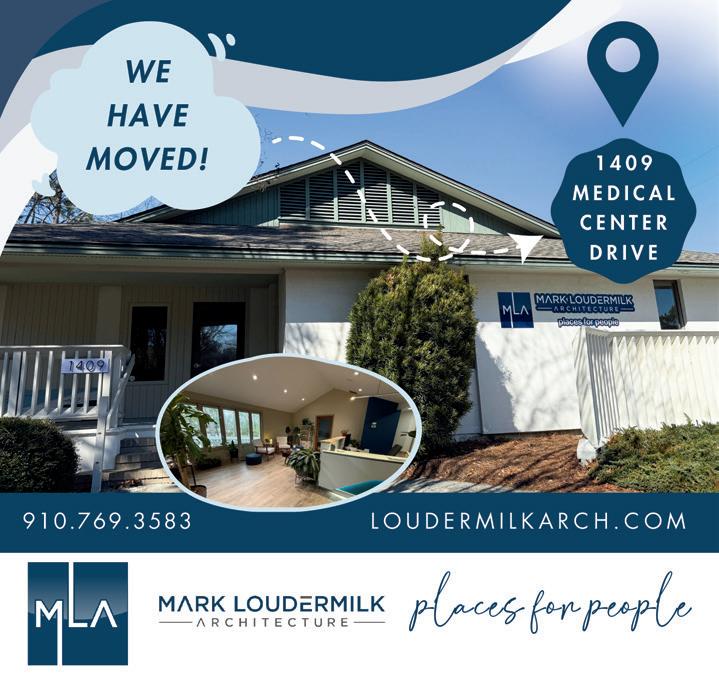
in UNCW began years before then when his father made a donation to help UNCW renovate an old building and turn it into the school’s new baseball field house.
“The chancellor at the time was Rosemary DePaolo, and I got to know her real well, and some of the trustees I knew on the board,” he said. “I got involved with UNCW Foundation and eventually ended up chairing that foundation. Then the next thing I know, they’re wanting me to be a trustee, and it just kind of morphed from that. I’ve been involved out there probably for the last 25 years.”
While real estate and UNCW take up a lot of his time, Carlton Fisher also devotes time to his family and hunting. He said he loves to travel with his wife and children and tries to play poker once a week.
He also loves hunting. He didn’t start hunting until he was 45, when he went on a wild boar hunt with his best friend, Hugh Caison, in South Carolina, he said. As they got more involved in hunting, Fisher and Caison decided to find hunting land of their own, eventually amassing 1,100 acres in Pender County and naming it Bear Garden.
“I love being out in nature,” Fisher said. “I love being out in the morning when it’s dark and you can see the stars and the woods come alive.”
Back at work, Carlton Fisher still runs Coastal Realty today, in an office in a Market Street shopping center.
Someone asked him recently when the bubble might burst. “I said, ‘You know, we’re not going to have a burst here,” Fisher said. “When we’ve had economic recessions, Wilmington has always done better (than other parts of the country) when times are bad, and we’ve done better when times are good because we’ve got a unique market here.”
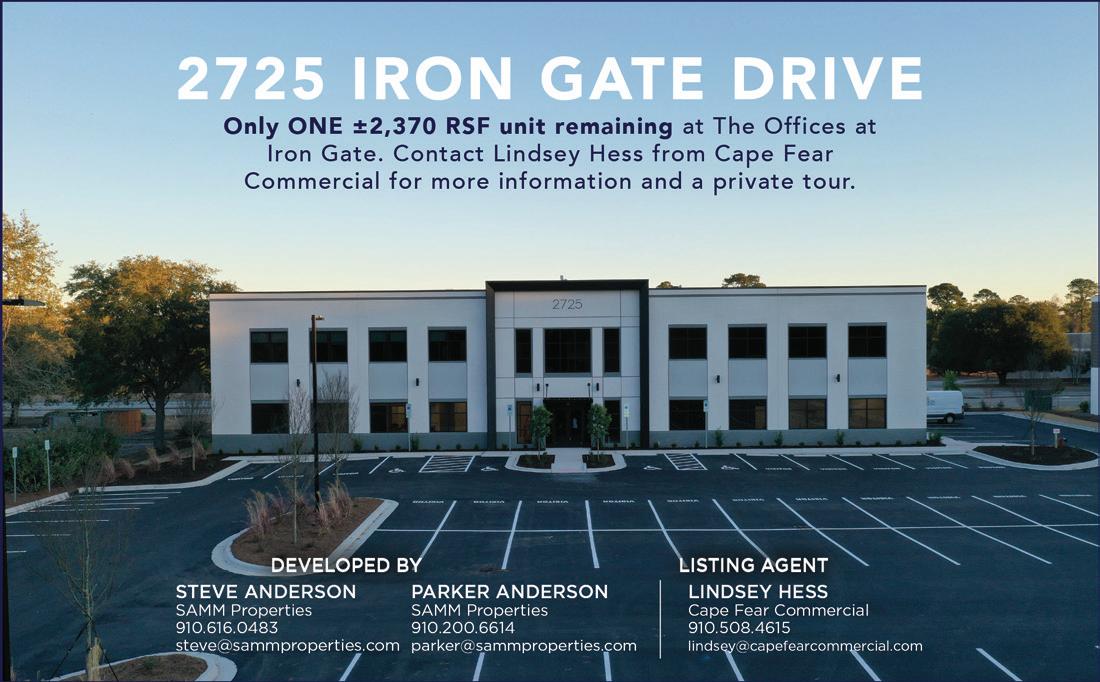


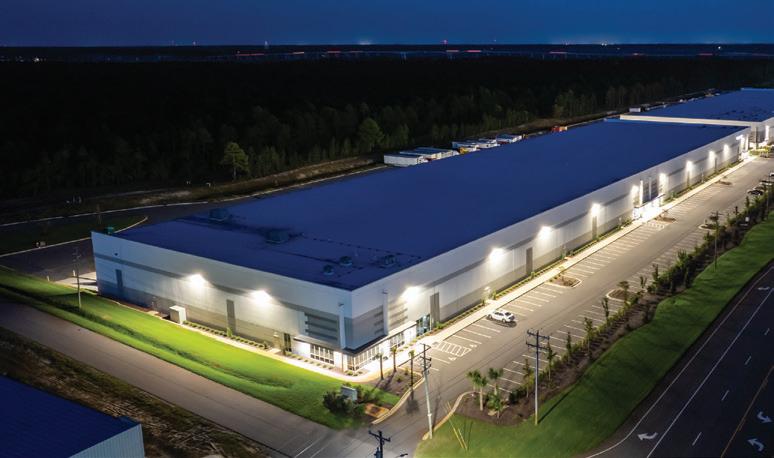

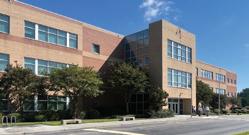
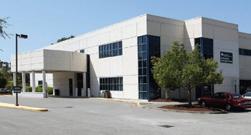
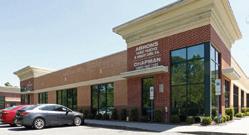
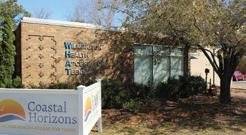


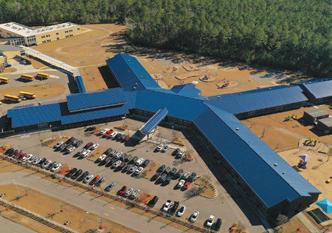
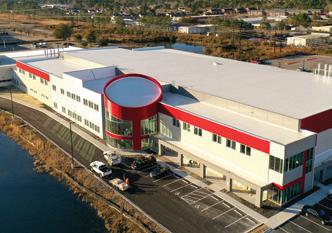
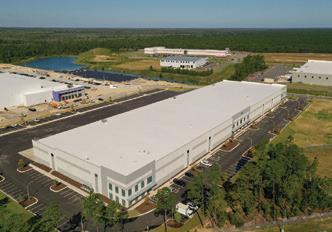
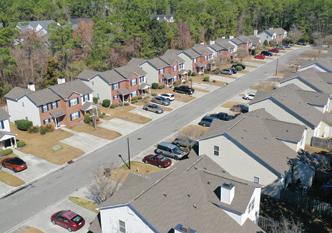
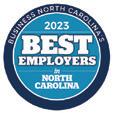

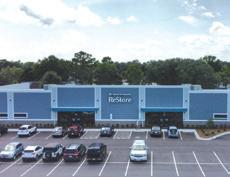
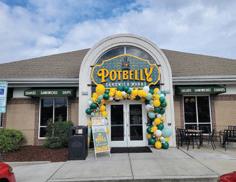
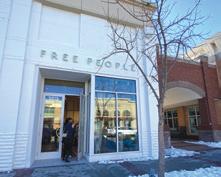
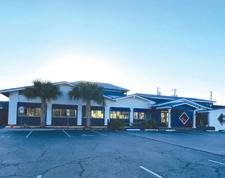


Seasoned restaurateur
Alex Zaragoza’s latest culinary venture, Vochos, reflects the chef’s deep love and respect for Mexico City’s vibrant culture and cuisine and his family’s heritage.
“My Mexican roots are the foundation of everything I do. Growing up, food wasn’t just about eating –it was about family, tradition and storytelling,” said Zaragozo. “Some of my best memories are of being in the kitchen with my family, watching as my parents and grandparents prepared dishes like birria, cochinita pibil and mole.”
Opening in January, Vochos Urban Mexican Kitchen, 1138 Military Cutoff Road in the Mayfaire area, embodies Mexico City’s culinary spirit by skillfully blending a sophisticated menu with enchanting influences from Asian, Peruvian and traditional Mexican cuisines. Vochos offers a unique mix of Mexican, Mayan and Asian dishes, featuring Mexicaninspired sushi, creative squid and octopus dishes and a variety of beef, pork and chicken options.
Upon entering Vochos, you are greeted by the golden wings of angels, symbolizing the majestic Angel de la Independencia that graces the skyline of Mexico City. The mural on the wall and the artwork above the bar vividly bring this iconic figure to life.
Another prominent design element of the restaurant is the red Volkswagen Beetle. These cars, commonly called Vochos, were often used as taxicabs in Mexico. The restaurant’s name pays homage to Zaragoza’s childhood memories of his uncle’s car. A restored 1974 Beetle sits outside the restaurant, reminiscent of the 1972 model that Zaragoza was promised for his 16th birthday but never received due to his

uncle’s financial struggles.
Vochos’ interior design exudes a relaxed elegance. Zaragoza said that his wife, Blanca Herrera, contributed significantly to the inspiration for the design’s finishing touches.
The food and enticing cocktail combinations, however, are what truly attract guests. Each dish is curated, showcasing a distinct range of continental ingredients, spices and flavors to tempt the palates of Wilmington residents.
“Mexican food is incredibly diverse, and I wanted each restaurant to showcase a different side of it,” he said. “Vochos Urban Mexican Kitchen takes a modern, urban approach with unique twists on traditional dishes. By creating distinct themes and menus, I can highlight the rich variety of Mexican cuisine and give people a different experience at each location.”
Brothers Alex, Eddie and Oscar Zaragoza have been key figures in promoting Mexican cuisine through their San Felipe restaurant chain, which has over 10 locations statewide. Alex Zaragoza heads BZAR Hospitality Group, including Chingön Taquerias and Papi’s Chicken in Leland. He serves as the executive chef at the Vochos location while managing the other restaurants.
“One of the best ways to keep up with trends is by constantly experimenting,” he said. “At Vochos
and Chingön Taqueria, I’m always testing new ingredients, techniques, and flavor combinations. Whether it’s modernizing a classic dish or introducing new brunch items, my goal is to push the boundaries while staying true to the essence of Mexican cuisine.”
This is evident in Vochos’ customdesigned drinks, which feature a variety of mezcal and tequila, many of which incorporate smoked elements. Unique tools, such as carafes, are used for infusing beverages instead of simply smoking the top. Additionally, there are classic-style cocktails with a twist, such as a Vochos’ old-fashioned or the mazapán martini.
Alex Zaragoza’s journey began in architecture, but his passion ignited in the restaurant industry while he worked part-time, inspiring him to pursue a culinary degree.
“Although I’m no longer working in architecture professionally, my background in it has had a huge impact on how I approach the design of my restaurants,” he said. “When I was planning Chingön Taqueria and Vochos, I took a lot of the design principles I learned from architecture –like space planning, flow and creating environments that evoke emotion. I wanted both restaurants to feel welcoming, with thoughtful layouts that make the dining experience enjoyable and functional.”
Alex Zaragoza is always creating and planning new and innovative ways to express his love for food.
“While there are no official new locations yet, I’m always looking for opportunities to grow and bring new concepts to life,” he said. “But for now, I’m focused on making sure my current restaurants keep evolving –starting with this amazing new brunch experience at Vochos. Expect dishes that blend bold Mexican ingredients with brunch favorites, along with unique cocktails to match.”
For more restaurant news, sign up for the weekly Feast Unwrapped email newsletter by going to FeastWilmington. com.


photo by MALCOLM LITTLE
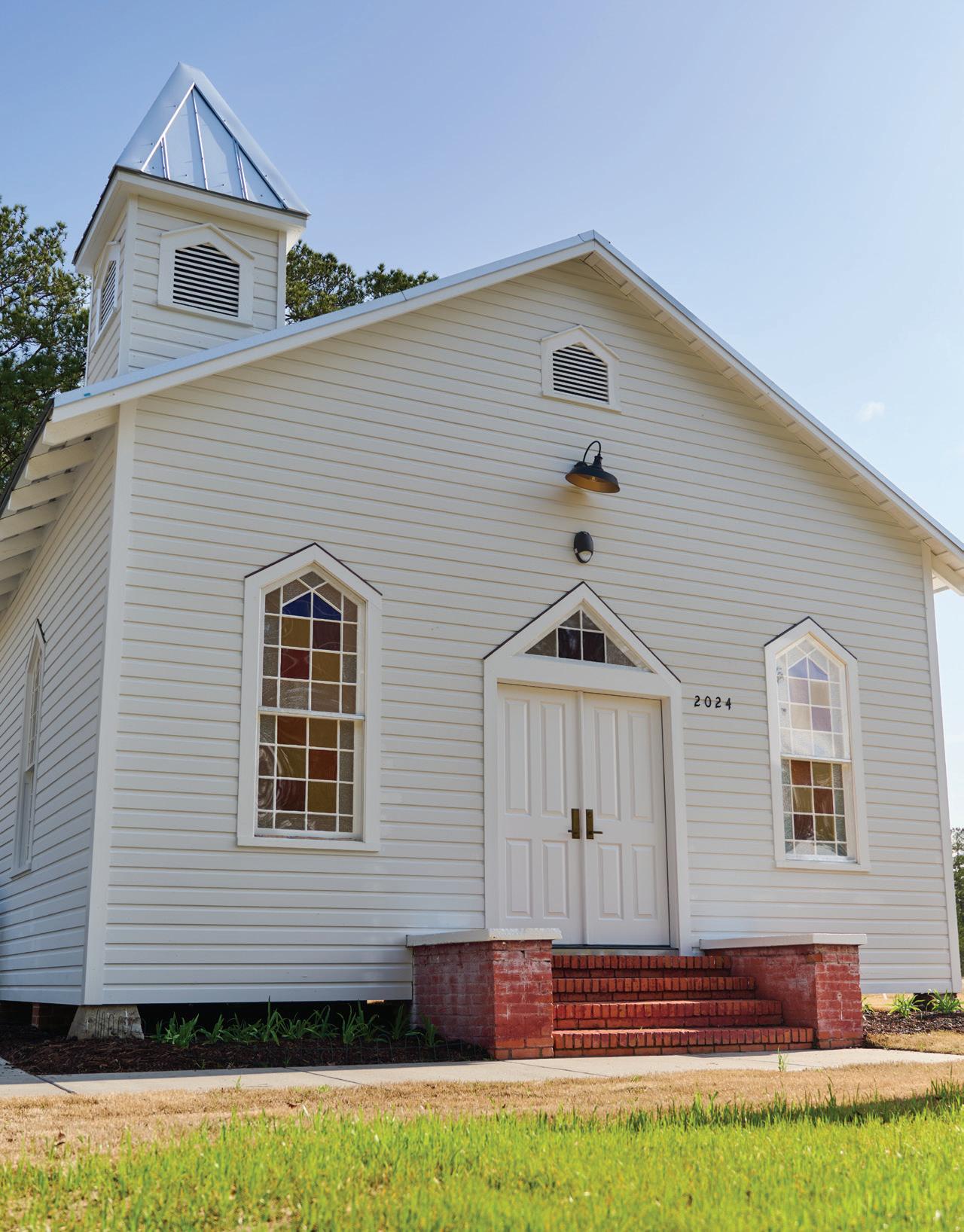
SIX YEARS AFTER RESTORATION WORK STARTED, OFFICIALS HELD A DEDICATION CEREMONY IN MARCH IN NAVASSA FOR REAVES CHAPEL – one of the oldest African American buildings in Southeastern North Carolina. The Civil War-era church was built along the banks of the Cape Fear River by people who had formerly been slaves at Cedar Hill Plantation. They, along with former slaves from neighboring rice plantations, made up the congregation. The building moved to its current spot on Cedar Hill Road where it served as an AME church for years but later fell into disrepair. Alfonso Beatty, president of the Cedar Hill/West Bank Heritage Foundation, who died earlier this year, spearheaded the project and worked with the Coastal Land Trust to utilize grant money to buy the church in 2019 and start the restoration. As part of that work, the church, which had to be stabilized, saw the return of its original walls and floors, as well as its original stained-glass windows. Officials now want to make the building a historic site.